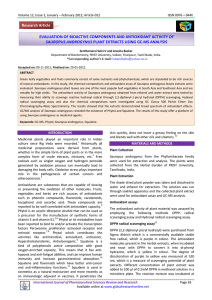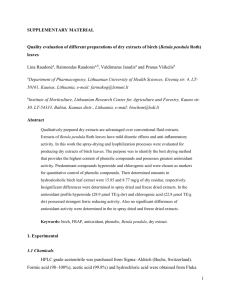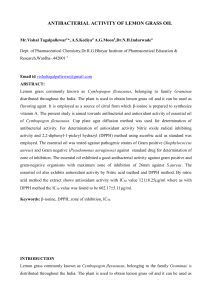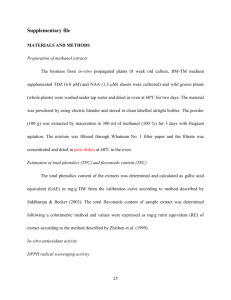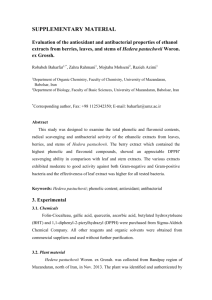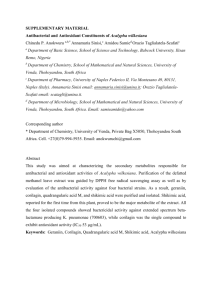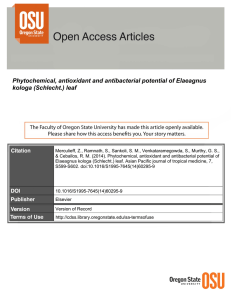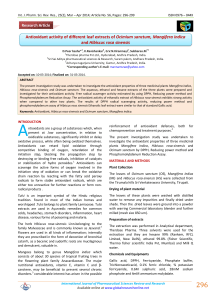cntctfrm_3a30bef9d2e7878a6d608b8ec78fe558_article (1)
advertisement
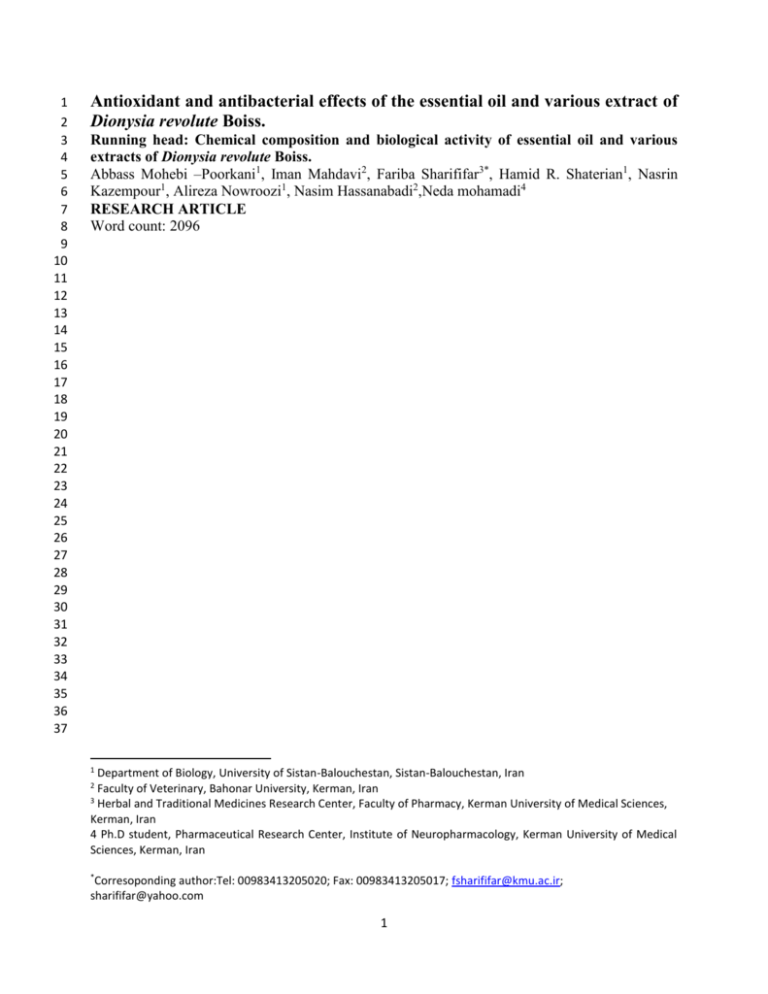
1 2 3 4 5 6 7 8 9 10 11 12 13 14 15 16 17 18 19 20 21 22 23 24 25 26 27 28 29 30 31 32 33 34 35 36 37 Antioxidant and antibacterial effects of the essential oil and various extract of Dionysia revolute Boiss. Running head: Chemical composition and biological activity of essential oil and various extracts of Dionysia revolute Boiss. Abbass Mohebi –Poorkani1, Iman Mahdavi2, Fariba Sharififar3*, Hamid R. Shaterian1, Nasrin Kazempour1, Alireza Nowroozi1, Nasim Hassanabadi2,Neda mohamadi4 RESEARCH ARTICLE Word count: 2096 1 Department of Biology, University of Sistan-Balouchestan, Sistan-Balouchestan, Iran Faculty of Veterinary, Bahonar University, Kerman, Iran 3 Herbal and Traditional Medicines Research Center, Faculty of Pharmacy, Kerman University of Medical Sciences, Kerman, Iran 4 Ph.D student, Pharmaceutical Research Center, Institute of Neuropharmacology, Kerman University of Medical Sciences, Kerman, Iran 2 * Corresoponding author:Tel: 00983413205020; Fax: 00983413205017; fsharififar@kmu.ac.ir; sharififar@yahoo.com 1 38 39 40 41 42 43 44 45 46 47 48 49 50 51 52 53 54 55 56 57 58 59 60 61 62 63 64 65 66 67 68 69 70 71 72 73 74 75 76 77 78 79 80 81 82 Abstract Objective: Dyonisia revoluta Boiss. is used in Iranian traditional medicine in gastric disordres and for wound healing. There are no studies for this plant in the literature. We aimed to study the chemical composition of the essential oil of the plant and assess the antioxidant and antibacterial effects of its essential oil and different extracts of this plant. Materials and methods: Essential oil was provided by steam distillation and analyzed with gas/chromatography and mass spectrometry. Essential oil, and various extracts were evaluated for antioxidant effect using diphenylpicrylhydrazil (DPPH) assay. Disk diffusion was used for antibacterial studies. Results and conclusion: GC/MS analysis indicated the presence of acetophenone (29.94%0), acetylphenol (20.23%), and benzaldehyde (14.26%) as main compounds of essential oil. Ethanolic extract showed the highest inhibition DPPH radical with IC50 = 98.8µg/ml in comparison to BHT (IC50 = 47.19µg/ml). Ethanolic and ethylacetate extracts showed inhibitory effect against the major of tested bacteria except E. aerogenes and C. freundii. Our results indicated that the ethanolic extract of this plant would be a good candidate for further studies. The essential oil of this plant also exhibited notable antioxidant which needs to be studied using the other methods to have valid results. Key words: Dionysia revoluta; Essential oil; Extract; DPPH; Disk diffusion 1. Introduction The role of oxidant agents has been known in pathogenesis of many disease such as diabetes, cancer, cardiovascular disease, (1). Essential oils are aromatic secondary metabolites of medicinal plants which as well as flavonoids and phenolics show different activities such as antimicrobial, antioxidant, anticonvulsant, anti inflammatory, diuretic...(2-6). The essential oils as well as phenols and flavonoids can act as antioxidants and antibacterial and have an important role in to prevention of different disorders which are associated with oxidative factors or bacterial agents (4, 7). Considering the problems with synthetic antioxidant and also the side effects and tolerance to common antibacterial drugs, there are many interests in finding new therapeutic agents especially from natural sources. The genus of Dionysia belongs to Primulaceae family and comprises more than 27 perennial specific species in Iran which restrict distributed in dry mountains. Some of these species also have been found in Iraq, Anatolia, Pakistan, Tadzikestan and Afghanistan (8). The plant of Dionysia revulata (Boiss.) subspecies revoluta is one of these endemic plants which has widely distribution in Iran. This plant is used in gastric disturbance and disinfection of wounds(9) . Previous studies have revealed the antibacterial effect of this plant against of Staphylococcos aureus in comparison to Erythromycin and Cephalexin (9). There are no study for chemical composition and antioxidant and antibacterial effects of this plant in the literature. In continuing the study of antioxidant and antibacterial effects of the extracts and essential oil of medicinal plants, we have studied this plant essential oil and different extracts for evaluation of these biological activity. 2. Materials and methods 2.1. Plant materials 2 83 84 85 86 87 88 89 90 91 92 93 The plant was gathered from the mountains of Sarikhani in Buanat in Fars Province at april, 2011. The plant was dried in shade and was confirmed by Dr. Mirtadzadini, Bahonar University. A voucher specimen was depoisted in Herbarium Center of Bahonar University. 2.2. Isolation of essential oil The amount of 200g of dried aerial parts of the plant was subjected to hydrodistillation for 3 h. using cleavenger apparatus to yeild 0.75% essential oil. 2.3. Plant extraction The ethanolic, aqueous and ethyl acetate extracts of the plant were provided by succhelet methods for 4h. and concentarted under vacuume to drying. The extracts and essential oil were stored at -20◦C until experiment. 2.4. Gas Chromatography (GC) of essential oil 94 95 96 97 98 99 100 The analysis of the essential oil was performed on an gas chromatograph Agilent HP-6890 (Agilent Technologies, Palo Alto, CA, USA) with a HP-1MS 5% phenylmethylsiloxane capillary column (30 m × 0.25 mm, 0.25 μm film thickness; Restek, Bellefonte, PA) equipped with an Agilent HP-5973 mass selective detector in the electron impact mode (Ionization energy: 70 eV). The temperature of injector and detector was set at 250 ◦C and 230 ◦C respectively. the temperature of oven was set at 40◦C at first for 1 min, and raised to 250 ◦C at 3◦C/min. Hellium was used as carrier (flow rate1ml/min. Diluted samples (1/100 in acetone, v / v ) of 1,0 l were 101 injected manually in the splitless mode. 102 103 104 105 106 107 2.5. Gas chromatography/mass spectrometry (GC/MS) Essential oils analysis was done with the same GC conditions (oven temperature, column, flow rate ) using an Agilent-HP 6890 gas chromatograph equipped with an Agilent 5973 mass selective detector in the electron impact mode (70 ev). Injector and MS transfer line temperatures were set at 250 ◦C and 230 ◦C, respectively. 2.6. Qualitative and quantitative analysis 108 109 110 For identifying the composition of the oil, relative retention time and mass spectra of each component was compared to standards. confirmation of compounds was performed by comparison of their mass spectra and retention indices relative to n-alkanes of with data 111 in the NISt and Wiley library (10). 112 113 114 115 116 117 118 119 120 121 122 2.7.DPPH free radical scavenging assay Antioxidant potential of the essential oil and extracts of the plant was evaluated using DPPH scavenging assay. 50µl of different concentrations of each sample was added to 5 ml of methanolic solution of 0.004% DPPHand incubated at room temperature for 30min., absorbance was read at 517nm(11) . Butylated hydroxytoluene (BHT) was used as reference drug.The percent of inhibition was calculated as follow: I%= (Acon-Asam)/Asam × 100, where Acon and Asam are the absorbance of control and sample respectively. 2.8. Antibacterial effect using disk diffusion method Antibacterial effect of the essential oil and extracts was studied by disk diffusion method against seven Gram-positive and gram-negative strains of Staphyloccocus aureus, Ataphyococcus 3 123 124 125 126 127 128 129 130 131 132 133 134 135 136 137 138 139 140 141 142 143 144 145 146 147 148 149 150 151 152 153 154 155 156 157 158 159 160 161 162 163 164 165 166 167 168 epidermidis, Pseudomons aeroginosa, Proteus mirabilis, Entrobacter aerogenes, Acinetobacter boumannii and Citrobacter freundii. The plant extracts were diluted in alcoholic solvents and prepared in concentration, of which 20 μl was droped on disk of 6 mm in diameter and the concentrations to give 100µg/disk and 10µl/disk of plant extracts and essential oil respectively. Turbidities of tested bacterial strains were prepared to 0.5 McFarland and inocula were spread on Mueller Hinton Agar (MHA) and incubated at 37 Cº for 18-24 hours (12). Inhibition zone were measured using vernier caliper. The tests were undertaken triple and the results were reported as mean ± SD. 3. Results and discussion 3.1. GC/MS analysis of essential oil The essential oil obtained from D. revoluta was pale yellow in with distinct, sharp odor. Forthy –eight compounds were identified, representing 94.51% of the total oil components (Table 1). As shown, the major components of the oil were found to be acetophenone (29.94%0), acetylphenol (20.23%), benzaldehyde (14.26%). Phenyl propanoids and benzene derivatives comprise the highest percentage of the total oil (66.21%). Oxygenated sesquiterpenes constitute about 12.00% of the oil. Our results showed differences in composition with respect to data in the literature, such as those reported for the essential oil derived from the D. diapensifolia. It is for the first time that the composition of the essential oil of D. revoluta has been reported. 3.2. Antioxidant activity The results of antioxidant effect show that ethanolic extract and essential oil of D. rivoluta can potentially reduce the stable DPPH radical to yellow color. The highest potential of DPPH radical scavenging was due to the ethanolic extract with IC50 value of 98.8 µg/ml in comparison to BHT (IC50= 47.19). The essential oil, aqueous and ethyl acetate extract exhibited inhibition with IC50 values of 0.77µl/ml, 126.0 and 264.8µg/ml respectively in a dose dependent manner. The highest percentage of DPPH inhibition percentage of ethanolic extract was 81.6% (200 μg/ml).The lower antioxidant activity of fractions like essential oil or ethyl acetae extract might be due to the absence and/or lower amount of the donor groups such as phenolics or terpenes in these fractions. Monoterpenes with methylene group exhibit potent antioxidant effect which attributed to the presence of methylene groups in monoterpene hydrocarbons (13). 3.3. Results of antibacterial effect The result of antibacterial activity of the essential oil and different extracts of D. rivoluta have been shown in Table 2. The ethanol extract showed antibacterial activity against several of Gram-positive and Gram-negative strains except E.aerogenes and C.freundii. Amongst the tested strains, A. boumannii and and S. aureus showed most sensitivity to ethanolic extrac ( inhibition zone diameter 11 and 12 respectively). The ethyl acetae extract exhibited weaker effect than that provided by ethanolic extract against S. aureus, A. baumannii, P. earoginosa and P. mirabilis. This fraction and the essential oil have more prominent inhibitory effect against C. freundii. and A. boumannii The other strains showed resistance to the essential oil. All the other strains were resistant to essential oil except E. aerogenes and C.freundii bacteria. No antibacterial effect was shown by aqueous extract. 4. Conclusion It is for the first report for the antioxidant and antibacterial effects of the genus Dionysia. And it is the second study for the chemical composition of this genus. Our results indicated that the ethanolic extract of this plant would be a good candidate for further studies. The essential oil of this plant also exhibited notable antioxidant which needs to be studied using the other methods to have valid results. 4 169 170 171 172 173 174 175 176 177 178 179 180 181 182 183 184 185 186 187 188 189 190 191 192 193 194 195 196 197 198 199 200 201 202 203 204 205 206 207 208 209 210 211 212 213 214 215 5. Acknowledgement Authors are so grateful from Dr. Mirtadjaldini for his help for the identification of the plant. References 1. Losso JN, Shahidi F, Bagchi D. Anti-angiogenic functional and medicinal foods Taylor & Francis; 2007. 2. Bakkali F, Averbeck S, Averbeck D, Idaomar M. Biological effects of essential oils- A review. Food and Chemical Toxicology. 2008;46:446-75. 3. Sharififar F, Mirtajaldini M, Azampour M, Zamani E. Essential oil and methanolic extract of Zataria multiflora Boiss. with anticholinesterase effect. Pakistan Journal of Biological Sciences. 2011:1-5. 4. Sharififar F, Nudeh GD-, Mirtajaldini M. Major flavonoids with antioxidant activity from Teucrium polium L. Food Chemistry. 2009;112:885-8. 5. Sharififar F, Mozaffarian V, Moradkhani S. Comparison of antioxidant and free radical scavenging activities of the essential oils from flowers and fruits of Otostegia persica Boiss. Pakistan Journal of Pharmaceutical Sciences. 2007;10:3895-9. 6. Sharififar F, Yassa N, Mozaffarian V. Bioactivity of major components from the seeds of Bunium persicum (Boiss.) Fedtch. . Pakistan Journal of Pharmaceutical Sciences. 2010;23:300-4. 7. Sharififar F, Yassa N, Shafiee A, . Antioxidant activity of Otostegia persica ( Labiateae) and its constituents. Iranian Journal of Pharmaceutical Research. 2003:235-9. 8. Mozaffarian V. A dictionary of Iranian plant names. Tehran: Farhang Mo’asern PubL; 1998. 9. Saadatmand S, Alaediny A, Salehy M. Antibacterial effects of dionysia revoluta essence on staphylococcos aureus and determination of biochemical component by GC-MASS method. The Quarterly Journal of Biological Sciences Spring 2009; 1(2):57-63. 2009;1:57-63. 10. Adams R. Identification of essential oil components by gas chromatography/mass spectroscopy. illinoise: Allured Publishing Co.; 2001. 11. Burits M, Bucar F. Antioxidant activity of Nigella sativa essential oil. Phytother Res. 2000;14:3238. 12. Bradshaw LJ. Laboratory Microbiology. New York: Saunders College Publishing; 1992. 13. Tepe B, Daferera D, Sokmen A, Sokmen M, Polissiou M. Antimicrobial and antioxidant activities of the essential oil and various extracts of Salvia tomentosa Miller (Lamiaceae) Food Chemistry. 2005;90:333-40. 5 216 217 Table 1. The results of GC/MS analysis of the essential oil of D. revoluta No 1 2 3 4 5 6 7 8 9 10 11 12 13 14 15 16 17 18 19 20 22 23 24 25 26 27 28 29 30 31 32 33 34 35 36 37 38 39 40 41 42 Retention (Rt) 7.592 7.837 9.397 10.35 11.44 11.68 11.84 12.21 13.34 13.58 15.50 15.83 16.06 16.47 16.79 16.94 17.34 19.83 20.18 20.63 20.94 21.39 24.05 26.03 28.42 30.17 33.22 34.96 35.27 38.22 38.87 39.60 39.82 39.98 40.12 43.18 43.69 44.62 45.16 46.31 47.23 time Name Percentage Styrene Heptanal 3,5-Xylenol Benzaldehyde 6-Methyl-5-hepten-2-one 2,4-Heptadienal 2,3-Dehydro-1,8-cineole 3-Ethyl-1,4-hexadiene Ο-Cymene Salicylaldehyde Acetophenone Cis-Linalool oxide 1-Octanol τ-Linalool oxide 6-Methyl-3,5-heptadiene-2-one Nonanal Linalool 2-Acetylphenol Borneol 4-Terpineol Methyl salicylate β-Farencyl alcohol 2-Decenal 2,4-Decadienal Eugenol Geosmin 1,3-cyclopentadiene, 5,5-dimethyl-2-propyl Dihydro-β-agarofuran 2H-benzocycloheptene-2-one,3,4, 4a,5,6,7,8,9octahydro-4a-methyl Rosifoliol Saelin 4,7(11)-diene γ-Eudesmol 7-Epi-α-selinene α-Eudesmol β-Eudesmol 1H-cycloprop[e]azulene,1a,2,3,4,4a,5,6,7b Fonenol 2-Propen-1-one,1,3-diphenyl Paradisiol 3-phenylpropiophenone Hexahydrofarensylalcohol 6 0.12 0.11 0.13 14.20 0.14 0.05 0.12 0.09 0.09 0.57 29.94 0.1 0.13 0.16 0.06 0.09 1.45 20.23 0.2 0.12 0.14 2.29 0.08 0.18 2.9 0.11 0.51 0.12 0.28 3.69 0.36 3.99 0.71 1.01 0.79 0.68 0.93 0.46 1.71 0.76 0.79 43 44 45 46 47 47.66 49.49 53.35 54.93 55.78 Globulol β-Phenyl-2-hydroxypropiophenone Dibenzoylmethane ο-Hydroxychalcone Phytol Total Phenyl propanoids Hydrocarbon monoterpenes Oxygenated monoterpenes Hydrocarbon sesquiterpenes Oxygenated sesquiterpenes 0.23 0.54 0.65 2.11 0.39 94.51 66.21 .59 7.5 1.4 12 218 219 220 221 222 223 224 225 226 227 228 229 230 231 232 233 234 235 236 237 238 239 240 241 242 243 244 245 246 247 248 7 249 250 251 252 Table 2. The results of Antimicrobial effect of the essential oil and different extracts of D. revoluta by disk diffusion method (diameter of zone of inhibition in mm, mean value of three independent experiments) sample 253 Microorganism S. S. aureu epidermid s is NI NI Essential oil Ethanol 11±1. 10± 0.6 extract 1 Ethylaceta 7± NI te extract 0.4 Aqueous NI NI extract NI: no inhibition E. aerogen es 11± 0.7 C. freund ii 7± 0.3 P. aeroginosa P. mirabilis NI NI NI NI NI 10± 0.9 9± 0.9 12± 0.6 7± 0.4 11± 0.6 8± 0.6 8± 0.3 8± 0.5 8± 0.4 NI NI NI NI 254 255 256 257 258 259 260 261 262 263 264 265 266 267 268 269 8 A. bauma nnii 270 271 272 273 Figure 1- The results of antioxidant evaluation of various extracts of D. revolute Boiss. using DPPH scavenging assay in comparison to BHT 274 275 276 277 278 279 280 281 282 283 284 285 286 287 288 289 290 291 292 293 294 295 296 297 298 299 300 9 301 302 303 Figure 2- The results of antioxidant evaluation of different concentration of essential oil of D. revoluta using DPPH scavenging assay 304 305 306 307 308 309 310 311 312 313 314 315 316 317 318 319 10

